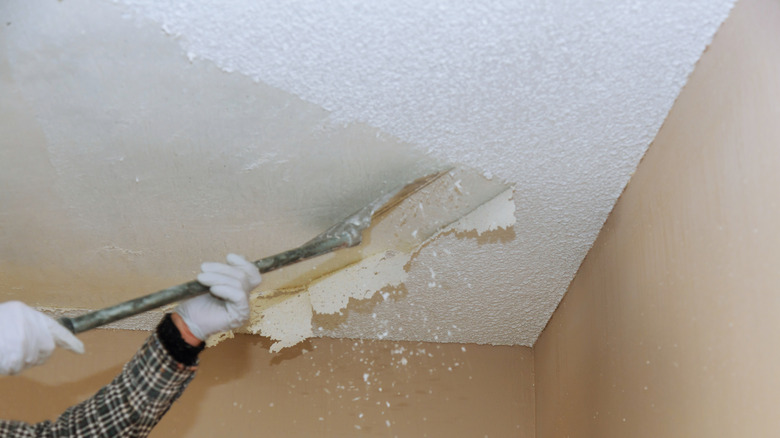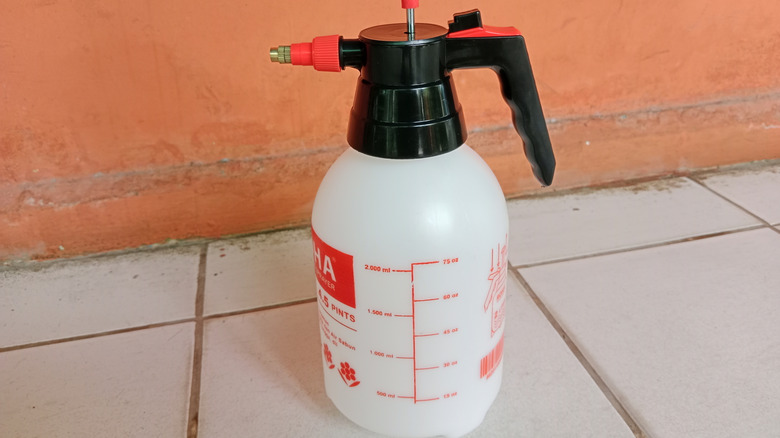The Water Trick That Makes Removing Popcorn Ceilings More Convenient
We may receive a commission on purchases made from links.
Popcorn ceilings are a dated relic of the past, but they refuse to die. They're awkward, bumpy, and unattractive, yet they're still present in tons of homes across the United States. While they've gone largely out of style since their surge in popularity in the 1940s and 1950s, they tend to linger much past their prime simply because they're a headache to deal with and remove. That is, for those who don't know about the water trick that makes removing popcorn ceilings much more convenient. To get smooth ceilings by removing popcorn texture, use the wet scrape method. This method is exactly what it sounds like: spray a popcorn ceiling with water and scrape it off. It's affordable and only requires a few supplies. In addition, it's really simple and doesn't require much expertise.
However, it has some significant caveats. Most importantly, you need to be absolutely sure that your popcorn ceiling does not contain asbestos. Asbestos was widely used for insulation last century, but it's incredibly dangerous when inhaled or swallowed. Scraping asbestos will release particles into the air, which can cause cancer and severe lung diseases. While these ceilings were banned in 1978, homes built and renovated into the 1980s could have asbestos since manufacturers could use up their stock, and some older buildings still have them. Steer clear of the wet scrape method in that situation. Instead, call a licensed asbestos professional to deal with your ceiling renovation. The other caveat of this method is that it works much better on ceilings that are not painted, where the water can penetrate the popcorn ceiling. If you've decided it's time to say goodbye to your painted popcorn ceilings, it's best to sand off the paint and use a chemical stripper to help it come off.
How to do the wet scrape method at home
If you're sure your popcorn ceiling is asbestos-free and unpainted, gather your tools. To work on the ceiling comfortably, grab a stable ladder. Since you'll need to scrape everything by hand, choose a scraper tool that's comfortable and easy to handle, like a basic metal drywall scraper. You can also use a Homax ceiling texture scraper, which has a wider blade to work more efficiently. To spray the water, use a basic spritz bottle or a garden sprayer. The larger the tank, the easier it will be to cover the ceiling without having to run up and down the ladder to get a water refill.
Also, keep in mind that this scraping method is rather messy. Therefore, it's absolutely necessary to protect your furniture, walls, and floor from drips and soggy popcorn texture material. Since you'll be using water, make sure to use a protective layer that's waterproof, like a plastic drop cloth. It's also important to wear a mask and goggles to protect yourself from the white dust that scraping will release.
Now that you're ready, it's pretty simple. Spray a small section of the ceiling with water, and let it sit for about 15 minutes. There's a fine line between wetting the ceiling enough to help it come off easily and completely drenching it and damaging the drywall behind it. To be safe, start small, try to scrape, and add more water if needed. While scraping, hold your tool flat against the ceiling. Holding the tool perpendicular to the ceiling will likely leave marks or gouges behind that will need to be fixed. Unpainted popcorn ceiling texture should come off easily when wet, but be patient, go slow, and use firm but steady pressure rather than rushing it.

